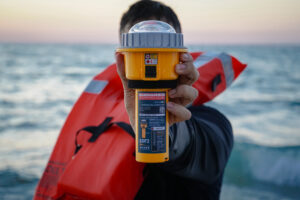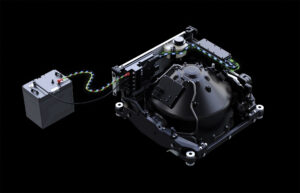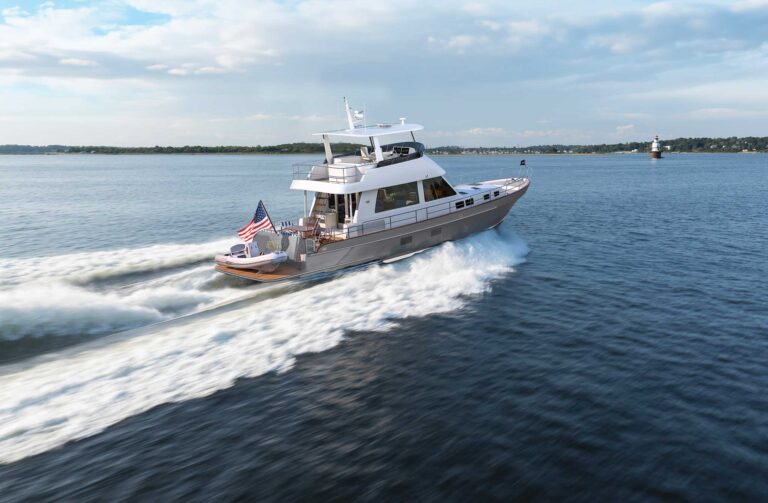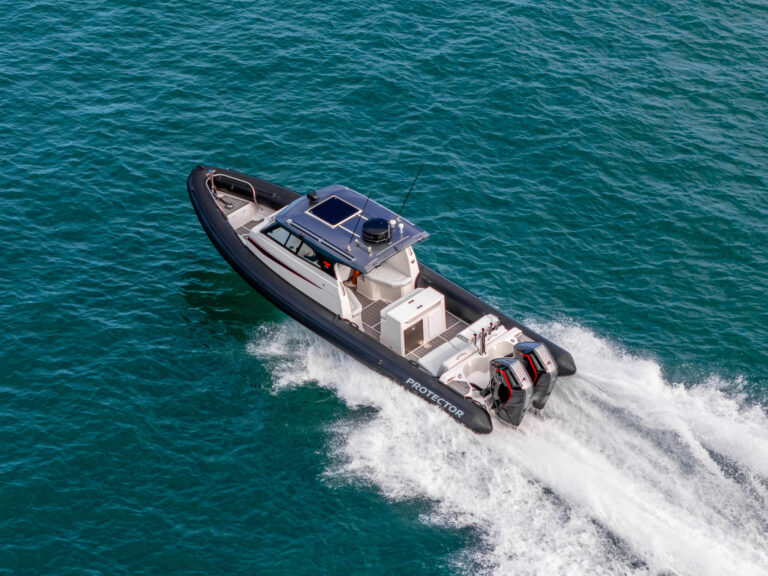Like cars, trucks and boats, trailers and engines should be locked and secured, even if it’s just to keep honest people honest.
Like cars, trucks and boats, trailers and engines should be locked and secured, even if it’s just to keep honest people honest.
For this article, I worked with products designed to secure outboards, sterndrives and trailers from several manufacturers. Most are simple to use and should provide an effective deterrent to all but the most determined thief. These are my results.
Coupler locks
Trailers are often stolen out of driveways and launch-ramp parking areas, both with and without boats on them. There are products for use when the trailer is coupled to the tow vehicle and others for use when the two are disconnected. If your trailer isn’t coupled to the tow vehicle, a well-constructed coupler lock is a good theft deterrent.
Most coupler locks consist of a solid piece that fits around the front of the coupler nose and another portion that closes the ball socket. These pieces are locked together using an integral lock cylinder, preventing someone from hooking up and towing the trailer away. In addition, it blocks most other methods of accessing the coupler, including the use of most portable trailer dollies and hooks.
The Master Lock Coupler Lock (379DAT) I’ve been using is heavily constructed from stainless steel, and its installation provides good visual as well as physical deterrence. The Master Lock consists of two pieces — the shackle body and the sliding ball, which slides in and out from the body to ensure a snug fit in different style couplers.
To install the lock, insert the key and turn it to position No. 1 (as depicted in the instruction sheet), slide the shackle body away from the ball, and insert the assembly into the unlatched trailer coupler. Turn the key to position No. 2, push the shackle closed, then turn the key to position No. 3 and remove the key. The assembly is now deadlocked to the trailer coupler.
Once installed, this is an intimidating-looking piece of gear. I attempted to dislodge it with a hammer and large punch, but only succeeded in cosmetically damaging the product. My concern if I continued hammering away was that I would damage the trailer coupler itself, not the lock. The inside portion of the lock is designed with contoured ridges that allow it to fit many coupler styles. The Master Lock 379DAT is designed to fit 1-7/8-, 2- and 2-5/16-inch couplers, and it worked well on my assortment of trailers.
Fulton, a company that manufactures the couplers on many boat trailers, provided me with its TP20 coupler lock(see photos at left). It’s designed to fit most 2-inch couplers, provided the coupler width doesn’t exceed 3-13/16 inches which, unfortunately, a few of mine do. It has an easy single-action, pick-resistant round key, making installation uncomplicated. A single 1/2-inch-diameter pin fits into the ball recess of the trailer coupler.
When installed, the Fulton coupler lock does not appear as intimidating as the Master Lock described above, but my attempts at forcibly removing it were just as unsuccessful. Both of these products should deter all but the most aggressive attempts to steal your trailer.
Latch lever locks
When a trailer is coupled to the tow vehicle — or as a secondary line of defense when uncoupled — the latch lever can be secured. The latch lever part of the coupler is designed to accept a simple safety pin to provide security from inadvertent uncoupling while towing. In place of the safety pin, I use a lock, adding another level of security when towing or storing the trailer.
There are several styles of latch locks available. I prefer the Master Lock Armored Trailer Lock with Shackle Guard (37D).More than just a standard padlock, it has a 3/4-inch armored shackle guard for cut and pry resistance, a hardened steel shackle for cut resistance, removable shackle sleeve for application flexibility, a pin tumbler mechanism for resistance to picking and, with the armor shield, it allows minimal room for cutting or prying. However, I found it cannot be used on some latch styles because of clearance issues created by the armor thickness.
Master Lock’s Adjustable Coupler Latch Lock (2847DAT, below) has a shaft that slides through the latch lever and locks in place with a tumbler assembly. The lock shaft has three distinct detents that allow it to accommodate latches of varying widths — 5/8 inch (16 mm), 1 inch (32 mm), and 2 inches (51 mm). This lock fit all of the trailer latches I tried it on and is more universally adaptable than the 37D discussed above.
One downside to the adjustable lock is that the exposed shaft provides easy access for cutting with a saw. I would stack washers on both sides of the shaft to take up the extra space and make it more difficult to cut. Both of these products provide additional security to an uncoupled trailer by locking the latch in the closed position, further deterring someone from towing away the trailer.
Wheel locks
One sure way of keeping your trailer where you parked it is by preventing the wheels from turning. Fulton offers a unique wheel lock that does just that. The TK100 Trailer Keeper adjusts to fit most trailer wheels up to 15 inches in diameter. It discourages trailer theft by immobilizing one wheel.
The TK100 is constructed of hardened, powder-coated steel that resists tampering and sawing. The system consists of an adjustable tire hook, a short sleeve/rod assembly, a lug latch and a brass padlock with removable pin. To set up the TK100 you must remove one lug nut from the forward half of the trailer wheel and install the lug latch, followed by reinstalling the original lug nut. The rod assembly hooks into the lug latch, and the tire hook is slid into place around the front of the tire and into the sleeve/rod assembly. Drop the padlock pin through to adjust the unit’s length, and snap the padlock body into place. It’s much easier than it sounds, and the instructions are very clear, with good diagrams.
Unfortunately, it is recommended that the lug latch be removed prior to using the trailer, which makes the installation a bit time-consuming for daily use. For long-term or seasonal storage, however, I really like the TK100. It is a great visual deterrent and certainly prevented my wheel from turning when I attempted to tow the trailer.
I have a shelf full of assorted trailer locks for evaluation, and when I heard of several break-ins in my neighborhood a while back, the first product I installed was the TK100. It’s big, bright in color and obvious, which should say “look elsewhere” to a thief. I found it to work as advertised.
Fulton’s 6-foot vinyl-coated steel cable lock(below) also can be used to secure two wheels together on a tandem trailer. With single-axle trailers it can be used around the frame and through one wheel. The lock mechanism is not a separate padlock, but becomes an integral part of the cable assembly when installed. The result with either of these products is similar, but the cable lock isn’t as obvious as the TK100, making the Trailer Keeper a better deterrent. In either case, most thieves would not want to tow a trailer down a street with wheels screeching and bounding along.
Draw bar locks
Equally as important, yet often overlooked, is the tow vehicle draw bar (ball mount). Securely locking the trailer to the tow vehicle means locking the draw bar to the receiver as well. The Master Lock Swivel Head Receiver Hitch Lock (2866DAT, below) replaces the traditional 5/8- or 1/2-inch pin that holds the ball mount to the tow vehicle. Simply remove the existing pin and replace it with the key-lockable 2866DAT.
The lock comes with a sleeve so it can be used with hitches rated for different towing weights. With the sleeve, the lock can be used on Class III/IV 2-inch receiver tubes requiring a 5/8-inch-diameter pin with a 10,000-pound load rating. Remove the sleeve, and it can be used on Class II 1-1/4-inch receiver tubes using a 1/2-inch pin with a 5,000-pound load rating.
Both the pin and sleeve are stainless steel, and the four-pin brass lock cylinder is covered by a watertight cap. Many of the Master Lock products discussed here are available in sets that are keyed alike.
Small outboard locks
Small outboards — those up to 40 hp — have a clamp-screw mounting system that allows easy installation and removal from the transom. However, this also makes them prime targets for theft.
The clamps normally comprise course-thread screws that are hand-tightened by wings or knobs. I evaluated several styles of locking devices for these engines, all of which are designed to prevent the mounting system from being operated. The most common design is used by Master Lock, Fulton and Durasafe. These products are designed to be installed over both clamp handles and locked in place, preventing the clamps from being unscrewed. The Stazo smartlock(right) is installed over a single clamp, though two could be used if you felt the need. Both styles do the job, but with different levels of installation complexity.
The Master Lock outboard lock, which is case-hardened and vinyl-coated, slides over the clamp wings and is secured with a two-piece padlock consisting of a pin tumbler mechanism and brass shackle. Although it does the intended job of limiting access to the clamps, I found it a bit of a juggle working with three components while my tender is afloat. However, I have used this product for more than 10 years, and it certainly does the job.
The Fulton outboard lock accomplishes the same task, but operates differently. The powder-coated steel body forms an upper and lower clamshell on the outboard clamps. With only two pieces and an integral key lock in the lower section, it’s a bit easier to install than the Master Lock.
The Durasafe assembly has a unique one-piece design that allows one-hand installation, so you can brace yourself in the boat with the other hand. It consists of a vinyl-coated steel sleeve that slides over the outboard clamp and a brass lock barrel that’s permanently attached to the sleeve. The lock barrel slides in and out of the sleeve and features a reversible key, adding to the product’s user friendliness. The Stazo is designed to be installed on a single clamp screw and is manufactured from thick-walled stainless steel.
The lock body is installed between the clamp-screw foot and the transom. It can be held in place by the engine clamp — which complicates the engine installation — or secured to the transom with the provided single screw. Once the engine is installed, the sleeve is simply slid over the lock body and clamp screw. A high-security Abus lock with key code card adds to its value.
Q-LOK(below) takes a different approach to securing small outboards. Its method is the least obtrusive once installed, but requires a bit of time for initial setup. Also, it’s less conducive to quick installation and removal of the outboard than some of the other products.
That being stated, as my tender is suspended by davits and the outboard is removed only at season’s end, I have been using the Q-LOK and will continue to do so. I like its appearance and believe it works well for the level of security I require.
The Q-LOK is constructed of 316 stainless and hardened steel and is available in three sizes to fit most small outboards to 30 hp. Installation requires the removal of the handles from the outboard’s clamping system, a simple process. On my older 9-hp Mercury, I needed to drill out the swivel pins, which took a few minutes. Using a No. 11 drill bit, I enlarged the holes slightly, per the instructions.
The Q-LOK consists of three tubular sections, a set screw, a threaded locking screw and one installation tool. The tubular sleeves slide within each other, and the hardened ends are inserted into the previously drilled holes in the outboard clamps. The length of the sliding tubes is adjusted and locked in place using the set screw. The outer sleeve is then slid back to cover the set screw, and the threaded locking screw is installed with the special key wrench.
Large-outboard, sterndrive locks
Large outboards and sterndrives are unceremoniously attached to the transom with nuts and bolts. In some areas, these engines and drives are stolen at an alarming rate.
Large-outboard locks are designed to lock the bolt that holds the engine or sterndrive mounting flange on the transom. McGard and Q-LOK — two companies that provided locks for me to work with — both offer locks for most outboards, based on a specific engine’s installation bolt diameter and thread pitch. McGard says its outboard locks are identical in quality and construction to its sterndrive locks.
Installation is simple. The locks work by replacing one of the existing mounting nuts with the lock assembly, using the specially coded installation tool. The threaded nut is enclosed by a free-spinning stainless steel collar and can only be installed or removed using the provided tool. The collar, not the nut, will turn if attacked by gripping tools or saw blades. The McGard lock nut must be installed with thread-locking adhesive (included).
The coded installation tool is similar in concept to the tools used with McGard’s automotive wheel lock system, which it has been providing for longer than I can remember. Although the installation tools look the same, I can assure you they are not, and if you don’t have the tool coded for your particular lock, it’s not going to work. McGard provides a registration card with the key number and, should you misplace the key, the company will sell you a replacement, though only if you’ve registered with them.
Q-LOK has taken this concept a bit further. Installation takes a bit longer, but it’s still easy. With this system, the entire bolt and nut are covered, creating ultimate frustration for anyone looking to tamper with them. After removing the mounting bolt, Q-LOK suggests installing its optional bolt head shield and seal cover before reinstalling the bolt. This will assure that the bolt’s hex head cannot be tampered with. You then install the Q-LOK stainless steel washer against the outboard or sterndrive mount — which serves to center the stainless steel shield — followed by the original outboard nut with a bit of thread locker (included).
The main stainless steel shield gets slipped over the bolt, followed by a nylon washer and guard nut, again with thread locker. The guard nut installation tool is a three-prong wrench that securely drives the locking nut tight. Both the bolt head shield and the main shield have stainless steel end covers that are pressed into the respective openings and need to be firmly seated with a hammer. The caps have a thick, protective cover that allows installation without marring the finish. Once installed, just pry off the shield.
As an added security measure, drop the second nylon washer into the main sleeve and fill the sleeve with 3M 5200 adhesive prior to installing the end cap. Q-LOK provides guidance for removing the entire assembly, but it is time-consuming and impractical for would-be thieves.
I recommend using any of these locks on two bolts per engine, and go with the upper transom bolts to keep the locks out of the water.
There are a number of good products available for protecting your boat, trailer and engine. And their cost is minimal compared to the products they are guarding. For peace of mind and protection, make the time and effort to install them. It’s part of being a prudent boater.










